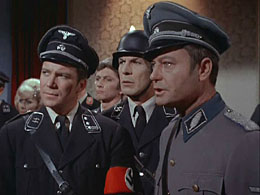Nazi Germany
Nazi Germany (also refereed to as Hitler's Germany and The Third Reich, formally the Greater German Reich) refers to Germany under the fascist dictatorship of the National Socialist German Workers' Party, circa 1933-1945. The Nazi Regime was defeated by the combined efforts of the Allied Nations (most notably the Union of Soviet Socialist Republics, The British Empire, and United States of America) during the second world war
The Nazi military serves as source material for the Star Trek episode "Patterns of Force".
Beliefs and Ideology
National Socialist ideology (clearly explained in Adolf Hitler's book, Mein Kampf) was highly racist, dividing up the world's population up into a strict hierarchy of races. At the top were the Aryans (Western Europeans), beneath whom were the Slavs, Asians and Blacks, who they believed to be mentally inferior to Aryans and were to be used as slaves. Beneath them were the Jews, whom they believed were a racial group in which every member, from birth to death, acted to control the world and bring misery upon the Aryans and must be destroyed. It was also Social Darwinist, believing that weakness needed to be bred out using eugenics, and homophobic. It was highly romantic and placed a great emphasis on aesthetics.
The Nazis believed that they were to push east and carve out an Empire out of Russia to be colonized by Germans. Their move to do so failed.
Nazi German Military
The Military of Nazi Germany (Wehrmacht) was divided into three main branches
- Heer (Army)
- Luftwaffe (Air Force)
- Kriegsmarine (Navy)
In addition, the Nazi Party itself had its own armed forces in the Waffen-SS.
The military of Nazi Germany was rebuilt basically from scratch during the 1930s. After the conclusion of the Great War the size of the German Military was scaled back to a defensive force of 115,000 men. After Hitler's rise to power, he began to rebuild the armaments industry. Combined with mass conscription, the German army was eventually capable of mobilizing over 20,000,000 men (though not simultaneously).
One of the key aspects of the German Military that was responsible for their success was that of doctrine. Although combat aircraft and tanks were both used during the Great War and proved their usefulness, it was not exactly clear on how to best use them. The German military provided tanks and aircraft to Fascists during the Spanish civil war, took notes on how to best make use of them and created doctrine around this fact, as well as eventually developing better and more efficient AFVs. German armor was not the best during the opening stages of the war, but they did have a decent understanding of how to make use of it which gave them an edge over foes such as France and Poland. Towards the end of the war, the Germans managed to keep up with technological developments and was a leader in several fields, namely rocketry and jet engine technology.
The main focus of Nazi Germany was on army and airpower. The Navy was a secondary priority. The Kriegsmarine was comparatively small, so it's purpose was not to fight the British navy but to disrupt enemy supply lines. Among it's main objectives was building a fleet of submarines to try and starve out Britain.
The Nazi military was, in the end, overcome for several reasons. The first was the sheer force that was levied against it: the British Commonwealth, the USSR, and the United States had Germany outnumbered by a large degree. In addition, the German industrial base was outproduced. For example over the course of the war the Soviets fielded 80,000 T-34 tanks and the US fielded 50,000 M4 Shermans. Germany produced less than 27,000 tanks of all types for use during the second world war. Germany also quickly overextended its supply lines during its invasion of Russia, which left its armies without ammunition and fuel.
Use of Nazi Aesthetics in Science Fiction
The Nazis have a number of iconic images associated to them, including their insignia, uniforms, rallies and architecture. Hitler himself took a keen interest in such matters. These aesthetics are often represented in science fiction to denote villain status or to represent fascist qualities. Among these are...
- Imperial Navy uniforms in Star Wars
- The Helghast in Killzone
- The Principality of Zeon
- Certain units of the Imperial Guard
Use of Nazism in Debate
For its obvious evils, Nazism is nearly universally reviled. This fact is often used in debates, sometimes figuratively and sometimes as a cheap ploy to gain the upper hand. Uses include accusing a person that has political ideologies they find objectionable of Nazism, even when the ideology is antithetical to Nazi ideas and denounced by the Nazi party. A similar ploy is "reductio ad Hitlerum", in which someone misuses the fact that an opponent shares some tendencies or viewpoints with Hitler or the Nazi party. The flaw is that not everything the Nazis believed in was evil; for example, Hitler owned a Dog and loved his mother: this does not make dogs or mothers evil.
See also
- The Big One (TBO)
- White supremacists AKA Trolling Donkey-palm fuckers
- The Holocaust
